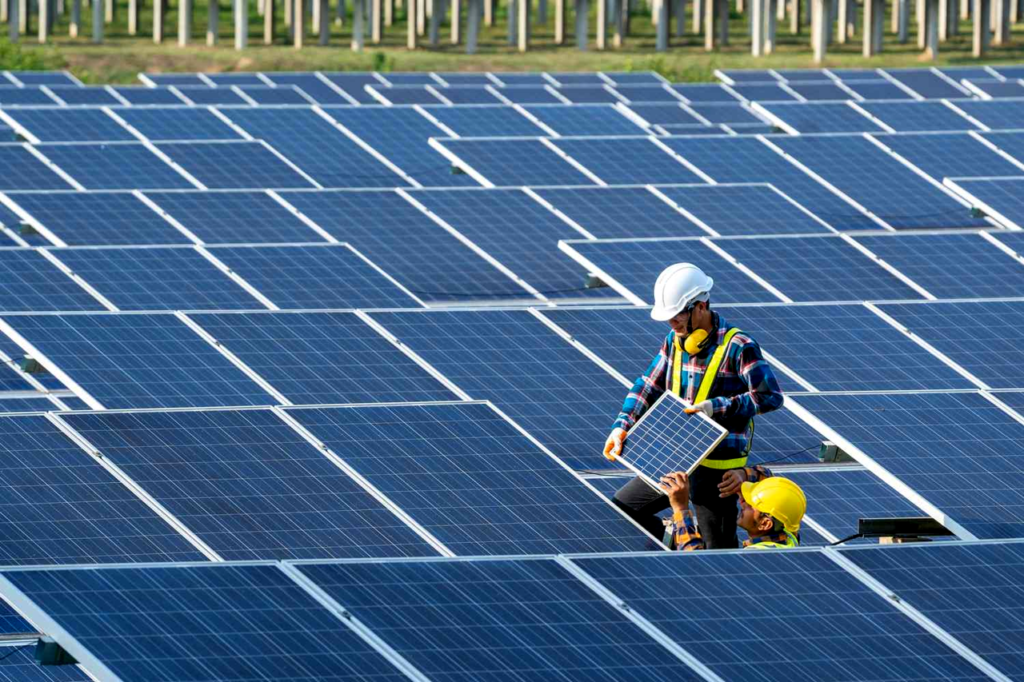Clean energy has emerged as a beacon of hope in our quest for a sustainable and eco-friendly future. As the global community grapples with the impacts of climate change, the importance of transitioning to cleaner and renewable energy sources cannot be overstated. In this article, we will delve into the world of clean energy innovations, exploring the advancements that are shaping the future of power generation.
Read More: The UK Response to Climate Change: Tech Solutions for a Greener Future
Contents
- 1 Powering the Future: Innovations in Clean Energy
- 2 Solar Power Revolution
- 3 Wind Energy: Blowing Towards Sustainability
- 4 Hydroelectric Energy: The Power of Water
- 5 Geothermal Energy: Earth’s Hidden Power
- 6 Innovations in Energy Storage
- 7 Smart Grids: Revolutionizing Energy Distribution
- 8 Bioenergy: Greening Energy Production
- 9 Challenges and Opportunities in Clean Energy
- 10 Future Trends in Clean Energy
- 11 The Final Words
Powering the Future: Innovations in Clean Energy

Definition of Clean Energy
Clean energy, at its core, refers to power derived from renewable sources that have minimal impact on the environment. These sources include solar, wind, hydroelectric, geothermal, and bioenergy.
Importance of Transition to Clean Energy
The urgency to transition to clean energy is grounded in the need to reduce our reliance on fossil fuels, cut down on carbon emissions, and create a more sustainable energy ecosystem. The consequences of climate change underscore the critical importance of adopting cleaner and greener alternatives.
Solar Power Revolution
Harnessing Sunlight for Energy
At the forefront of clean energy innovations is the solar power revolution. This involves capturing sunlight and converting it into electricity through photovoltaic cells. The widespread adoption of solar panels on rooftops, in solar farms, and even integrated into everyday objects signifies a monumental shift in our approach to energy production.
Advancements in Solar Technology
Innovations in solar technology have propelled efficiency gains and cost reductions. Thin-film solar cells, solar paint, and other breakthroughs contribute to making solar energy more accessible and affordable. These advancements play a crucial role in the growing acceptance of solar power as a mainstream energy source.
Environmental Impact of Solar Power
While solar power is renowned for its environmental friendliness during operation, the manufacturing and disposal of solar panels raise environmental concerns. Sustainable practices in production and recycling are imperative to ensure the overall eco-friendliness of solar energy.
Wind Energy: Blowing Towards Sustainability
Utilizing Wind Turbines for Electricity
Wind energy harnesses the kinetic energy of the wind through the use of wind turbines, converting it into electrical power. Wind farms, both onshore and offshore, have become iconic symbols of sustainable energy production.
Growth and Potential of Wind Energy
The growth and potential of wind energy are evident in the increasing number of wind farms around the globe. Advances in turbine design, along with the exploration of offshore wind resources, contribute to the expanding role of wind power in our energy mix.
Addressing Concerns about Wind Power
Despite its benefits, wind energy is not without challenges. Visual and noise impacts, as well as concerns about its effects on bird populations, necessitate ongoing research and technological innovations to mitigate these issues.
Hydroelectric Energy: The Power of Water
Tapping into the Energy of Flowing Water
Hydroelectric power is generated by tapping into the energy of flowing water. Dams and turbines play a vital role in converting the potential energy of water into electricity, making it a significant contributor to global power generation.
Hydroelectric Power Plants and Their Functionality
Hydroelectric power plants come in various sizes, from large-scale dams to smaller run-of-river systems. Each type has its advantages and challenges, with considerations for environmental impacts being paramount in their design and operation.
Environmental Considerations
While hydroelectric power is classified as a clean energy source, it is not without environmental considerations. Alterations to river flow and potential impacts on aquatic ecosystems require careful management and sustainable practices in hydroelectric power generation.
Geothermal Energy: Earth’s Hidden Power

Tapping into the Earth’s Heat
Geothermal energy harnesses the heat stored beneath the Earth’s surface. This involves extracting heat from the Earth’s crust and converting it into usable energy, providing a constant and reliable source of power.
Geothermal Power Plants and Their Efficiency
Geothermal power plants, categorized as dry steam, flash steam, and binary cycle plants, showcase the efficiency of this energy source. Technological advancements continue to enhance the effectiveness of harnessing the Earth’s hidden power.
Sustainable Benefits of Geothermal Energy
Geothermal energy stands out for its sustainability, offering a continuous and reliable source of power. Its minimal environmental impact and ability to serve as a baseload power supply contribute to a stable and resilient energy grid.
Innovations in Energy Storage
Importance of Efficient Energy Storage
Efficient energy storage is paramount to managing the intermittency of renewable energy sources. Batteries, pumped hydro storage, and other technologies play a pivotal role in storing excess energy for later use, ensuring a consistent power supply.
Advancements in Battery Technology
Advancements in battery technology, such as the development of lithium-ion batteries and solid-state batteries, mark a significant step forward in energy storage capabilities. These innovations address the limitations of traditional energy storage methods and support the broader adoption of renewable energy.
Addressing Challenges in Energy Storage
Challenges in energy storage, including cost, scalability, and environmental impact, are actively being addressed through ongoing research. The quest for more sustainable and accessible energy storage solutions remains a focal point in the clean energy revolution.
Smart Grids: Revolutionizing Energy Distribution
Introduction to Smart Grids
Smart grids represent a paradigm shift in energy distribution. These systems leverage digital technology to enhance the efficiency, reliability, and sustainability of electricity distribution. Real-time monitoring, control, and optimization are key features of smart grids.
Improving Efficiency and Reliability
Smart grids contribute to improved energy efficiency by reducing losses during transmission and distribution. The ability to detect and respond rapidly to faults or outages enhances the overall reliability of the energy grid.
Smart Grids and Environmental Impact
Beyond efficiency gains, smart grids play a crucial role in reducing carbon emissions. By optimizing energy usage and integrating renewable sources seamlessly, smart grids contribute to building a more resilient and environmentally friendly energy infrastructure.
Bioenergy: Greening Energy Production
Harnessing Energy from Organic Materials
Bioenergy involves harnessing energy from organic materials, such as plants and agricultural residues. This renewable energy source offers a viable alternative to traditional fossil fuels and contributes to a more sustainable energy mix.
Types of Bioenergy Sources
Common bioenergy sources include biofuels, biogas, and biomass. Each source has unique applications and considerations, with sustainable production practices being essential to maximize the benefits of bioenergy.
Sustainability Challenges in Bioenergy
The production of bioenergy raises concerns related to land use, food production, and biodiversity. Sustainable practices, such as utilizing waste materials, are crucial in addressing these challenges and ensuring the positive impact of bioenergy.
Challenges and Opportunities in Clean Energy
Overcoming Barriers to Clean Energy Adoption
The adoption of clean energy faces various barriers, including high initial costs, policy challenges, and resistance to change. Creative financing models and public awareness campaigns are essential for overcoming these hurdles and accelerating the transition to cleaner energy sources.
Economic and Policy Considerations
Economic incentives and supportive policies play a vital role in fostering the growth of clean energy. Governments, businesses, and individuals need to collaborate to create an enabling environment for sustainable practices and innovations.
Global Cooperation for Sustainable Energy Future
The challenge of addressing climate change requires global cooperation. International collaborations, agreements, and technological exchanges are pivotal for achieving a sustainable and equitable clean energy future that transcends borders.
Future Trends in Clean Energy

Emerging Technologies
The future of clean energy holds exciting prospects with ongoing research and development introducing emerging technologies. Advanced solar panels, innovative wind turbine designs, and novel energy storage solutions are on the horizon, promising increased efficiency and accessibility.
Integration of Artificial Intelligence in Clean Energy
Artificial intelligence (AI) is becoming integral to optimizing energy production, distribution, and consumption. AI-driven solutions contribute to a smarter and more adaptive energy system, enhancing overall efficiency and effectiveness.
Predictions for the Next Decade
Looking ahead, predictions for the next decade include a substantial increase in renewable energy capacity, widespread adoption of electric vehicles, and a heightened focus on circular economy principles in energy production. These trends indicate a transformative period in our approach to energy sustainability.
Read More: The Future of UK Healthcare: How Technology is Transforming Medicine
The Final Words
Recap of Key Innovations
Innovations in clean energy are transforming the energy landscape. From harnessing sunlight and wind to tapping into the Earth’s hidden power and embracing digital advancements, these innovations collectively contribute to a cleaner, greener, and more resilient energy future.
Urgency for a Clean Energy Future
The urgency to transition to clean energy is undeniable. As the global community faces the challenges of climate change, adopting and advancing clean energy solutions is not just an option but a necessity for a sustainable and thriving future.




